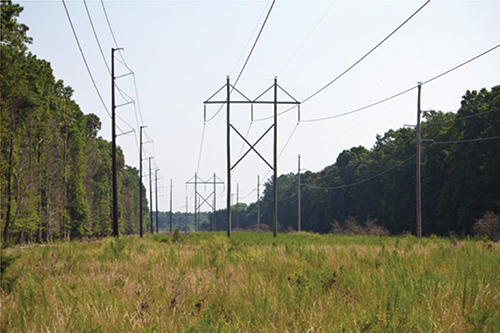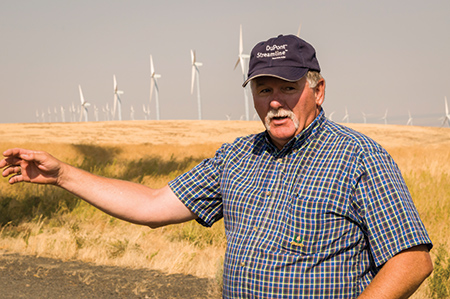One overgrown tree can interfere with electrical transmission and bring thousands of businesses and homes to a standstill. Effective vegetation management along utility rights of way is vitally important as utility companies face immense pressure to avoid outages and deliver safe, reliable energy.
The Federal Energy Regulatory Commission (FERC) has upped the ante on this issue by strictly enforcing transmission reliability standards. Utilities failing to meet stringent vegetation clearance guidelines for power lines face fines of up to US$1 million per day if vegetation-induced outages occur.
Many utilities are turning to trusted partners to help them create and implement integrated vegetation management (IVM) programs to keep vegetation under control and power flowing. There’s no silver bullet and no easy answers. Terrain, land use, environmental conditions, neighboring entities and other factors help determine the right mix of vegetation control techniques in each situation.
Fortunately, North American Electric Reliability Corporation (NERC), the organization designated by FERC to develop transmission reliability standards, gives land managers flexibility to customize plans that meet each site’s vegetation needs. Biological, chemical, mechanical, manual and cultural methods can all be part of the best IVM prescription.
Making it Local
Choosing the right weed control to match local conditions is an important component of any IVM plan. With thousands of miles of rights of way and hundreds of substations to service, weed control programs that help increase crew productivity are essential to meeting tight timeframes and working within budget constraints. The vegetation management industry continues to improve control options, with advanced products that offer more reliable brush and weed control at low use rates to increase crew productivity and reduce overall vegetation management costs.
Preparing and implementing an effective IVM plan calls for collaboration between utility companies, land management professionals, and landowners. Three custom application companies that partner with utility companies share how they help clear the way for safe, reliable power.
Systematic Approach Helps Identify Right IVM Plan
Joe Lentz, vice president of Arborchem Products, Mechanicsburg, PA., helps customers achieve their vegetation management goals with a systematic approach that maximizes the IVM program effectiveness and efficiency. Lentz has 29 years of experience in the vegetation management industry as an applicator, distributor and technical specialist.
“Whether I’m helping utility companies, invasive weed managers or departments of transportation, I use three main objectives when setting up an IVM program,” says Lentz. “First, we need to achieve a high percentage of control for unwanted vegetation. Second, we must operate productively by matching the application technique to the size and density of vegetation to be controlled. And third, we need to stay on target by using the right herbicide and application technique for site conditions. By following these three steps, we narrow the field of herbicide combinations and application techniques that will accomplish the task, whether it’s providing safe, reliable power, improving site lines on roadways or eradicating invasive weeds.”
Long-Term Solution
When working with utility companies who rely completely on mowing to maintain rights of way (ROWs), Lentz points out the benefits of employing herbicide applications as a long-term solution with economic advantages. “Brush that is mowed every two to three years keeps coming back with bigger root systems, so every time you mow, it costs more. Over 15 years, you’ve mowed the ROW five times,” Lentz explains. “If you follow the first mowing with a cut-stubble application, it will cost you a little more up front, but it’s likely you’ll never have to mow again. Every four or five years, a crew with backpack sprayers can treat regrowth at a lesser cost because you reduce stem density each time. Plus, you’ve cut out two applications over the 15 year period.”
Education Is Key
Describing the value of IVM programs for utilities is a top priority for Lentz. His team conducts more than 75 presentations a year, addressing local, regional and national utility personnel, applicators, pesticide and utility inspectors, industry association groups, and citizens.
“With high employee turnover rate and a lot of young people entering our industry, many people don’t understand the value of IVM,” notes Lentz. “Speaking to these groups really helps get the message out.”

Joe Lentz recommends cut-stubble applications to help minimize
mowing and brush control costs along rights of way
Solving Diverse Vegetation Control Challenges
The surrounding land where utility ROWs and substations are maintained by Mid Dakota Vegetation Management can vary from corn and soybean fields in Minnesota and South Dakota, to pastures and rangeland in Montana and Wyoming, to rocky, mountainous areas in the Black Hills. Whatever the challenge may be, Jack Doolittle and Andrew Canham, who own the Miller, SD, based company, work closely with their utility customers to provide the right herbicide program to fit within an overall IVM plan. “Proper herbicide application made in a timely manner can produce outstanding results in most situations,” says Doolittle. “For more than nine years, we have been controlling weeds and brush for our utility customers with effective herbicide treatments. We’ve had good success by communicating our recommended programs and maintaining a good working relationship with our customers.”
Individualized Programs
The company’s utility customers include Western Area Power, Xcel Energy, and Black Hill Power. To meet the diverse needs of each utility, Doolittle and Canham work with their Crop Production Services (CPS) and DuPont Land Management representatives to determine the right herbicide combination to meet each site’s needs.
In farming areas, where corn, soybeans and other crops are grown up to the base of utility structures and substations, applications must be made after crops are harvested, with extra care to keep applications on target. “That’s a big factor when selecting herbicides,” Doolittle says. “With the program we’re using, which is a tank mix that incorporates DuPont™ Perspective® herbicide and Esplanade herbicide, we haven’t had any problems with chemical relocation. It fits our program really well.”
Low use rates are another reason Doolittle relies on the Perspective® and Esplanade program. “Being able to treat a large number of acres without having to pull a trailer or bring an extra truck just to carry herbicides makes it that much easier for our crews.”

Low use rates help crews operate efficiently and maintain productivity
Safety Training
An important aspect of maintaining safe, reliable power supply is ensuring crew safety, notes Doolittle. His company holds training and safety meetings in the spring and summer, instructing applicators in application techniques and safe equipment operation. Whether making applications from a motorized terrain vehicle or backpacking by foot in the hills, safe herbicide application is a priority.
Program Prevents Fire, Keeps Sites Safe
With wild fires a common threat in the Hatch Grade mountain region near Touchet, WA, Kevin Brown and his crew at Kevin’s Custom Spraying make fire prevention a key focus of their vegetation management program for a site that includes 500 wind turbines. Owned and operated by Florida Power & Light, the wind farm is located in a remote mountain site, which adds special challenges for vegetation management programs.
Research-Based Program
As further proof about the benefits of IVM programs in ROWs, Lentz points to the 60-year State Game Lands 33 Research and Demonstration Area study, conducted on land near State College, PA. The cooperative study, conceived by Asplundh Tree Expert Co., was established by William Bramble and W. Richard Byrnes, both of whom later joined the faculty at Purdue University. Partners in the study included Pennsylvania Electric Company and Pennsylvania Game Commission.
“The study, which is unique to utility ROW vegetation management, shows the positive effect on wildlife habitat when herbicides are part of vegetation management plans,” Lentz says.
The project, which has tracked sites from 1953 to the present, pointed out positive effects on a plant community when herbicides are part of the vegetation control mix. “With so many brush species, we generally need more than one herbicide for control. Newer chemistries with lower use rates offer much more application flexibility and are much more effective.”
In bare ground applications at substations, Lentz has applied a tank mix including DuPont™ Perspective® or Viewpoint® herbicide with excellent results. According to Mr. Lentz, “These combinations have been Cadillac treatments for us. And with the low use rates, we’ve gone from applying pounds with previous products to just ounces per acre. Everyone who used them was extremely satisfied with the control they received.”
“Our top priority is keeping a 12- to 15-foot bare ground firebreak around the turbines and utility boxes,” Brown says. “We have lots of fires in this area and they can move fast, which makes it extremely important to keep vegetation away from the equipment.”
Protecting Crews
While wild fires can damage wind turbines, rattlesnakes pose a different threat for utility workers and applicators. “Keeping a clean setting around the turbines helps prevent workers from accidentally stepping on one of the area’s many rattlesnakes. The bare ground area also helps crews find dropped tools more easily instead of having to search for them in a patch of Russian thistles.”
Brown battles a number of difficult-to-control weeds that can fuel fires and hamper turbine maintenance. “In the fall, we applied a tank mix incorporating 10 ounces of DuPont™ Perspective® herbicide and 2 pounds of Spike herbicide,” Brown says. “That combination has done a great job of controlling tough weeds like Russian thistle, marestail and yellow starthistle. Before we used Perspective® we weren’t getting adequate marestail control.”
Fewer Trips, More Productivity
Crew productivity is another concern for Brown. Products that are effective at low use rates help his applicators maximize each trip to the remote wind farm location.
“In the past when we used products that were applied at 10 or 12 pounds per acre instead of ounces per acre, like Perspective®, we needed large volumes of water for mixing,” Brown explains. “Now when we’re making applications with a four-wheeler, we can use less water. It’s not easy getting to these sites, so the least amount of herbicide and water we have to carry on the truck, the better. By adding this latest product to our weed-control program, we’ve kept weeds under control with a fall application and eliminated costly, time-consuming return trips for retreatments the following summer.”

Reliable bare ground control around wind turbines is a priority for controlling wildfires
About the Author
 Dan Zapotok is the industrial vegetation management portfolio manager for DuPont Crop Protection, where he is responsible for products within the IVM, railroad and forestry markets. Zapotok has worked with DuPont for more than 20 years, holding positions in operations, project management and marketing. He earned a bachelor’s degree from Pennsylvania State University.
Dan Zapotok is the industrial vegetation management portfolio manager for DuPont Crop Protection, where he is responsible for products within the IVM, railroad and forestry markets. Zapotok has worked with DuPont for more than 20 years, holding positions in operations, project management and marketing. He earned a bachelor’s degree from Pennsylvania State University.
NOTES:
Always read and follow all label directions and precautions for use.
DuPont™ Perspective® herbicide is not registered for sale or use in all states. See your DuPont retailer or reperesentative for details and availbitiy in your state.
DuPont™ Perspective® herbicide is for use in non-crop applications only and does not have a grazing tolerance.
The DuPont Oval Logo, DuPont™, The miracles of science™, Perspective® and Viewpoint® are trademarks or registered trademarks of DuPont or its affiliates.
Esplanade is a registered trademark of Bayer CropScience.
Spike is a registered trademark of Dow AgroSciences LLC.







